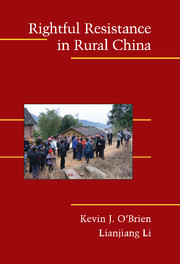Book contents
2 - OPPORTUNITIES AND PERCEPTIONS
Published online by Cambridge University Press: 05 September 2012
Summary
Is there truly a gap between the Center and lower levels that Chinese villagers can exploit? Rightful resistance cannot appear without divisions in the state or, put more simply, without patrons and villains. Potential activists must blame their troubles on misconduct by local officials and believe they have allies at higher levels whom they can turn to for help. The emergence of rightful resistance in rural China is thus a story about both opportunities and perceptions. There must be openings to exploit and villagers who can locate them and make the most of them.
Understanding Opportunities
Studies of political opportunity have become much more nuanced of late (Meyer and Minkoff, 2004; Tarrow, 1996). Researchers have moved beyond discussions of a single, national “opportunity structure” to examine under what conditions a particular opportunity inspires or discourages mobilization (e.g., Suh, 2001: 456). Students of movement origins increasingly appreciate that windows for action are often not open or closed but are partly opened (Sawyers and Meyer, 1999: 189), and that opportunities may vary by policy or group (Gamson and Meyer, 1996: 289; Tarrow, 1996: 42–43). When accounting for protest, there is new attention to contradictory trends and the complexity of external environments (Goodwin and Jasper, 1999: 53; Meyer and Minkoff, 2004: 1484). Reflecting calls to do more splitting to balance the lumping (Goodwin and Jasper, 1999: 53; Koopmans, 1999), scholars talk of the need to “unpack political opportunity” (Gamson and Meyer, 1996: 277) and to recognize that mobilization is often a question of “opportunities for what?
- Type
- Chapter
- Information
- Rightful Resistance in Rural China , pp. 25 - 49Publisher: Cambridge University PressPrint publication year: 2006



